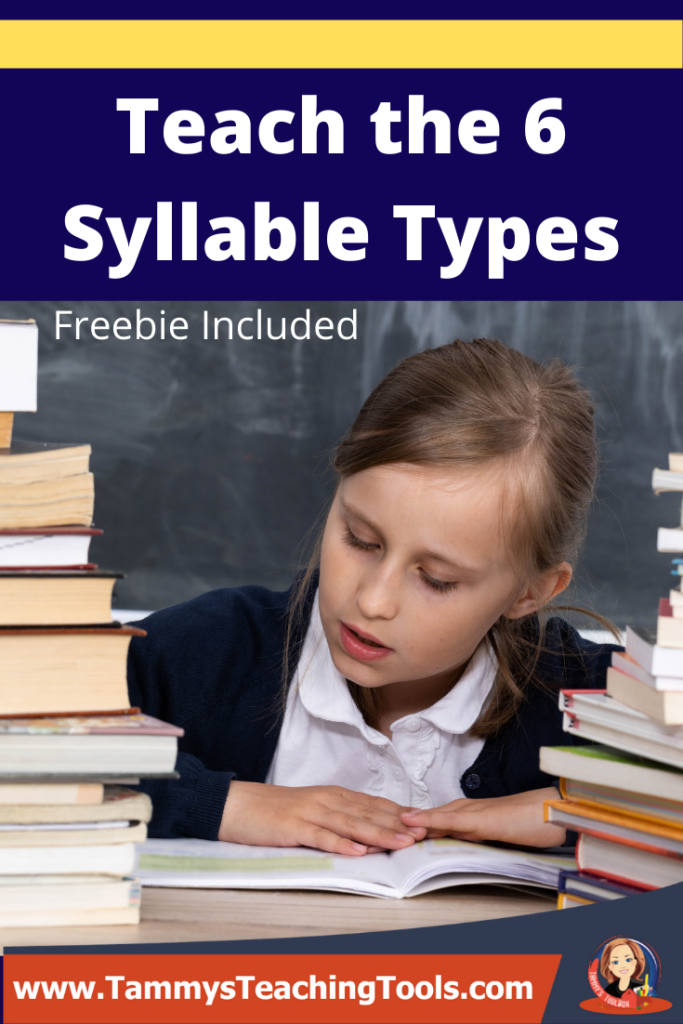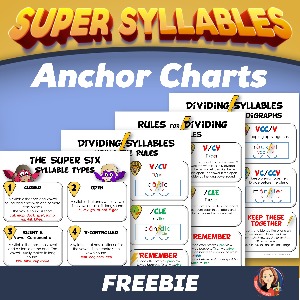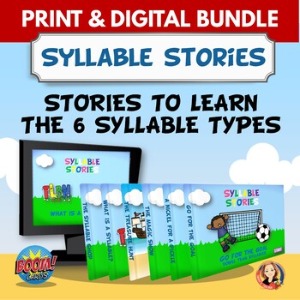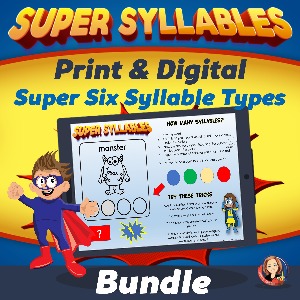Teaching the Six Syllable Types
Teaching your elementary readers to learn the six syllable types is key to developing strong reading and writing skills. With all the information and opinions on how and when to teach syllables, it is hard to know where to start. Here are some tips and activities you can use to teach syllable types in your classroom.
What are the Six Syllable Types?
 Before you start teaching your students about syllable types, make sure to familiarize yourself with each syllable type. See below to grab a free set of anchor charts that will not only help students remember information but give teachers a ready reference as well.
Before you start teaching your students about syllable types, make sure to familiarize yourself with each syllable type. See below to grab a free set of anchor charts that will not only help students remember information but give teachers a ready reference as well.
1. Open Syllables
First, open syllables have a vowel at the end of the word that makes a long vowel sound. Open syllables are included in words like we, she, he, and candy (with the long e sound at the end of the word).
2. Closed Syllables
Next, closed syllables have consonant sounds at the end of the word. These are words like jam, yum, and pop.
3. Vowel-Consonant-E
The third syllable type is vowel-consonant-e. This type changes the vowel sound in the word to a long vowel sound when a silent e is added to the end. Try cap to cape and tub to tube.
4. R-Controlled
Next, r-controlled syllables are when the letter r is paired with a vowel before it (or, ar, er, ur, ir) and controls the sound of the word. Words like sword, bird, and flower all use r-controlled syllables.
5. Vowel Team
A syllable with two vowels that act as a team to make one vowel sound. Words like meat, boat, great, pea-nut, pound, and crawl have vowel teams.
6. Consonant + le
Finally, the sixth syllable type is consonant + le. Consonant + le words end in a consonant followed by the letters le. Words like trouble, bubble, and candle use this syllable type.
Consonant + le is the only syllable without a vowel sound since the e is silent. It makes its own sound. You hear a schwa sound between the two consonants. The “le” sounds like “ul” (“bul”, “tul”, “ful”) Get your Free Syllable Types and Syllable Division Anchor Charts here.
Why Teach Syllable Types?
Knowledge of syllable types and syllable division rules is an essential skill for reading accurately and fluently. It provides a strategy for breaking words into manageable parts and correctly decoding those parts.
When readers can recognize syllable types, they have a way to determine if a vowel has a long, short, diphthong, r-controlled, or consonant-le sound. They can also draw on this knowledge to find correct spellings.
It is crucial that students can distinguish the sound of a syllable within a word and be able to manipulate that sound.
Using syllable types to help understand how words are formed and sound also help students recognize the patterns and systems in other words. It’s an instant vocabulary booster! In addition, syllable type activities integrate well with intervention and Orton-Gillingham programs.
Try These Ready-to-use Activities!
Digital Storybooks
Your young readers will understand the six syllable types when you tell them a story! Use these Syllable Stories: How Sounds Make Words. Stories to Learn the Six Syllable Types. Grades K-3
There’s a story to tell with every syllable type, and your students will love hearing the long and short vowel antics. Review activities follow each story, and they are also available in print format. See all six stories with print and boom cards.
Super Syllable Practice Packs
This set of 6 Super Syllable Practice Packs has everything you need to introduce and practice syllables. Starting with the basics and syllable counting and moving to reading multi-syllable words, there are tons of multi-sensory print and digital resources in each pack.
See the bundle of resources here.
Build a Box of Donuts – Syllable Game
I love playing syllable games with students! One of my favorites is the Build a Box of Donuts interactive game. When students choose the correct syllable to complete a word, they add a donut to their box. This is an awesome game to review open and closed syllables!
Syllable Puzzles
Not only puzzles fun, but they are also great teaching tools! Puzzles help your students think critically and activate that metacognition (thinking about their own learning process)!
Review syllable types with students by using Secret Picture Puzzles. By matching certain syllable types, your students will solve puzzles and undercover secret pictures.
Have fun using games, stories, and interactive activities to teach the essential skill of syllable division and the six syllable types.

You might like this post on teaching the VC/CV syllable division rule.





